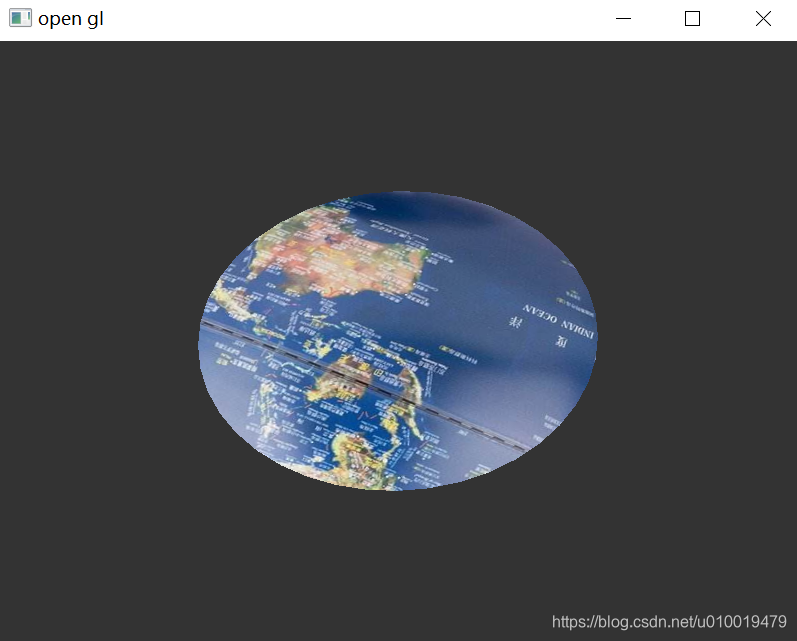#include <glad/glad.h>
#include <glfw3.h>
#include <iostream>
#include "myOpenGL.h"
#define STB_IMAGE_IMPLEMENTATION
#include "stb_image.h"
const unsigned int SCR_WIDTH = 800;
const unsigned int SCR_HEIGHT = 600;
void framebuffer_size_callback(GLFWwindow* window, int width, int height)
{
glViewport(0, 0, width, height);
}
float firstTriangle[] = {
-0.5f,-0.5f,0.0f,
0.5f,-0.5f,0.0f,
0.0f,0.5f,0.0f
};
const int n = 200;
GLfloat v[n] = { 0.0f };
GLfloat R = 0.5f;
const GLfloat Pi = 3.1415926f;
GLfloat angle = 2 * Pi / n;
void initVertex() {
for (int i = 0; i < n; ++i) {
v[i] = R * cos(2 * Pi / n * i);
++i;
v[i] = R * sin(2 * Pi / n * i);
++i;
v[i] = 0.0f;
++i;
v[i] = 1.0 - (GLfloat)((R * cos(angle * i)) + 1.0)*0.5;
++i;
v[i] = (GLfloat)((R * sin(angle * i)) + 1.0)*0.5;
}
}
void printVertex() {
for (int i = 0; i < n; i++) {
if (i % 3 == 0) {
std::cout << std::endl;
}
std::cout << v[i] << ",";
}
}
const char * vertexShaderSource = "#version 330 core\n"
"layout(location = 0) in vec3 aPos;\n"
"layout(location=1) in vec3 aColor;\n"
"layout(location=2) in vec2 aTexCoord;\n"
"out vec3 ourColor;\n"
"out vec2 TexCoord;\n"
"void main()\n"
"{\n"
" gl_Position = vec4(aPos,1.0);\n"
"ourColor = aColor;\n"
"TexCoord = aTexCoord;\n"
"}\0";
const char * fragmentShader1Source = "#version 330 core\n"
"out vec4 FragColor;\n"
"in vec3 ourColor;\n"
"in vec2 TexCoord;\n"
"uniform sampler2D ourTexture;\n"
"void main()\n"
"{\n"
" FragColor = texture(ourTexture, TexCoord);\n"
"}\0";
int main() {
glfwInit();
glfwWindowHint(GLFW_CONTEXT_VERSION_MAJOR, 3);
glfwWindowHint(GLFW_CONTEXT_VERSION_MINOR, 3);
glfwWindowHint(GLFW_OPENGL_PROFILE, GLFW_OPENGL_CORE_PROFILE);
GLFWwindow* window = glfwCreateWindow(SCR_WIDTH, SCR_HEIGHT, "open gl", NULL, NULL);
glfwMakeContextCurrent(window);
gladLoadGLLoader((GLADloadproc)glfwGetProcAddress);
unsigned int vs = glCreateShader(GL_VERTEX_SHADER);
glShaderSource(vs, 1, &vertexShaderSource, NULL);
glCompileShader(vs);
unsigned int fs = glCreateShader(GL_FRAGMENT_SHADER);
glShaderSource(fs, 1, &fragmentShader1Source,NULL);
glCompileShader(fs);
unsigned int sProgram = glCreateProgram();
glAttachShader(sProgram, vs);
glAttachShader(sProgram, fs);
glLinkProgram(sProgram);
initVertex();
printVertex();
unsigned int vbo, vao;
glGenVertexArrays(1, &vao);
glGenBuffers(1, &vbo);
glBindVertexArray(vao);
glBindBuffer(GL_ARRAY_BUFFER, vbo);
glBufferData(GL_ARRAY_BUFFER, sizeof(v), v, GL_STATIC_DRAW);
glVertexAttribPointer(0, 3, GL_FLOAT, GL_FALSE, 5 * sizeof(float), (void *)0);
glEnableVertexAttribArray(0);
glVertexAttribPointer(2, 2, GL_FLOAT, GL_FALSE, 5 * sizeof(float), (void*)(3 * sizeof(float)));
glEnableVertexAttribArray(2);
int width, height, nrChannels;
unsigned int texture;
glGenTextures(1, &texture);
glBindTexture(GL_TEXTURE_2D, texture);
glTexParameteri(GL_TEXTURE_2D, GL_TEXTURE_WRAP_S, GL_CLAMP_TO_BORDER); // set texture wrapping to GL_REPEAT (default wrapping method)
glTexParameteri(GL_TEXTURE_2D, GL_TEXTURE_WRAP_T, GL_CLAMP_TO_BORDER);
// set texture filtering parameters
glTexParameteri(GL_TEXTURE_2D, GL_TEXTURE_MIN_FILTER, GL_LINEAR);
glTexParameteri(GL_TEXTURE_2D, GL_TEXTURE_MAG_FILTER, GL_LINEAR);
unsigned char *data = stbi_load("2019-2-25.jpg", &width, &height, &nrChannels, 0);
glTexImage2D(GL_TEXTURE_2D, 0, GL_RGB, width, height, 0, GL_RGB, GL_UNSIGNED_BYTE, data);
glGenerateMipmap(GL_TEXTURE_2D);
stbi_image_free(data);
glfwSetFramebufferSizeCallback(window, framebuffer_size_callback);
while (!glfwWindowShouldClose(window))
{
glClearColor(0.2f, 0.2f, 0.2f, 1.0f);
glClear(GL_COLOR_BUFFER_BIT);
glUseProgram(sProgram);
glBindVertexArray(vao);
glDrawArrays(GL_TRIANGLE_FAN, 0, 40);
glfwSwapBuffers(window);
glfwPollEvents();
}
}
void initVertex() {
for (int i = 0; i < n; ++i) {
v[i] = R * cos(2 * Pi / n * i);
++i;
v[i] = R * sin(2 * Pi / n * i);
++i;
v[i] = 0.0f;
++i;
v[i] = 1.0 - (GLfloat)((R * cos(angle * i)) + 1.0)*0.5;
++i;
v[i] = (GLfloat)((R * sin(angle * i)) + 1.0)*0.5;
}
}这段代码是整个程序的核心,它定义了纹理坐标,和顶点位置,xyzst 。
整个程序难就难在,纹理坐标和顶点坐标的转换,上面代码就完成了这一点,然后把数据传给顶点着色器(Vertex Shader)进行解析,然后再传给片段着色器(Fragment shader)。
这里有opengl的教程https://learnopengl-cn.github.io/01%20Getting%20started/04%20Hello%20Triangle/#_3。





















 1308
1308











 被折叠的 条评论
为什么被折叠?
被折叠的 条评论
为什么被折叠?








